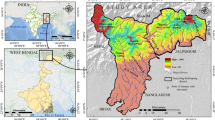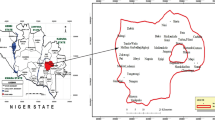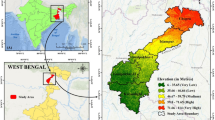Abstract
In the present study, identification of groundwater zones that are affected by anthropogenic contaminants based on litho-hydrogeological parameters has been attempted using multi-criteria decision analysis–analytical hierarchy process (MCDA–AHP) technique in an agriculturally intensive Arang block of Raipur district, Chhattisgarh, Central India. Litho-hydrogeological factors, such as geological and aquifer characteristics, land use–land cover, depth to water table, soil type, rainfall distribution, slope, geomorphological features, drainage density, elevation and lineament density parameters are considered for the delineation of anthropogenic contamination zones based on an integrated index model in Arc-GIS. Various input layers were assigned weights and then weight normalization process was adopted using Saaty’s AHP method to develop the integrated potential anthropogenic contamination zone (PACZ) map, based on the relative importance of anthropogenic contamination of groundwater. According to the proposed model majority of the study area falls under precarious zone, though certain areas fall under safe zone. In course of time, without proper planning the area could turn out to be moderately unsafe to unsafe zone. The PACZ map was validated with the fluoride concentration in groundwater as per National Rural Drinking Water Programme (NRDWP) report along with the measured nitrate concentration values. Model accuracy was achieved by agreement of about 82% of the fluoride values and 94% of the nitrate values with the proposed output map. Further validation of the model with fluoride and nitrate data was performed using computing similarity analysis with Pearson’s correlation coefficient which suggests anomalously higher concentrations of fluoride and nitrate ion concentration in certain areas of Arang block, which could be emanated from non-point anthropogenic sources. Additionally, Gibbs’s plot and saturation indices of fluorite and calcite suggest that groundwater chemistry is primarily controlled by aquifer lithological characteristics (rock–water interaction) and diffused anthropogenic contamination sources.









Similar content being viewed by others
References
Ahada CP, Suthar S (2018) Groundwater nitrate contamination and associated human health risk assessment in southern districts of Punjab. India Environ Sci Pollut Res 25:25336–25347. https://doi.org/10.1007/s11356-018-2581-2
Akinlalu AA, Adegbuyiro A, Adiat KA, Akeredolu BE, Lateef WY (2017) Application of multi-criteria decision analysis in prediction of groundwater resources potential: a case of Oke-Ana, Ilesa Area Southwestern, Nigeria. NRIAG J Astron Geophys 6:184–200. https://doi.org/10.1016/j.nrjag.2017.03.001
Al-Abadi AM, Al-Shamma’a AM, Aljabbari MH (2017) A GIS-based DRASTIC model for assessing intrinsic groundwater vulnerability in northeastern Missan governorate, southern Iraq. Appl Water Sci 7:89–101. https://doi.org/10.1007/s13201-014-0221-7
Alabdula’aly AI, Al-Rehaili AM, Al-Zarah AI, Khan MA (2010) Assessment of nitrate concentration in groundwater in Saudi Arabia. Environ Monit Assess 16:1–9. https://doi.org/10.1007/s10661008-0722-7
Alonso JA, Lamata MT (2006) Consistency in the analytic hierarchy process: a new approach. Int J Uncertainty Fuzziness Knowledge Based Syst 14:445–459. https://doi.org/10.1142/S0218488506004114
Al-shabeeb AR (2016) The use of AHP within GIS in selecting potential sites for water harvesting sites in the Azraq Basin—Jordan. J Geogr Inf Syst 8:73. https://doi.org/10.4236/jgis.2016.81008
Amalraj A, Pius A (2013) Health risk from fluoride exposure of a population in selected areas of Tamil Nadu South India. Food Sci Hum Wellness 2:75–86. https://doi.org/10.1016/j.fshw.2013.03.005
Appelo C, Postma D (2005) Geochemistry, groundwater and pollution. 2nd edn. A.A. Balkema Publishers, Netherlands
Avtar R, Singh C, Shashtri S, Singh A, Mukherjee S (2010) Identification and analysis of groundwater potential zones in Ken-Betwa river linking area using remote sensing and geographic information system. Geocarto Int 25:379–396. https://doi.org/10.1080/10106041003731318
Ayoob S, Gupta AK (2006) Fluoride in drinking water: a review on the status and stress effects. Crit Rev Env Sci Technol 36:433–487. https://doi.org/10.1080/10643380600678112
BIS (2012) (Bureau of Indian Standards) IS: 10500 Indian Standards for Drinking Water—Specification. Second revision, New Delhi
Bonsor HC, MacDonald AM, Davies J (2014) Evidence for extreme variations in the permeability of laterite from a detailed analysis of well behaviour in Nigeria. Hydrol Process 28:3563–3573. https://doi.org/10.1002/hyp.9871
Boumans L, Fraters D, van Drecht G (2008) Mapping nitrate leaching to upper groundwater in the sandy regions of The Netherlands, using conceptual knowledge. Environ Monit Assess 137:243–249. https://doi.org/10.1007/s10661-007-9756-5
CGWB (2011) Central Ground Water Board, Ministry of water resources, Government of India. Groundwater exploration in Chhattisgarh state, pp. 114–120
CGWB (2013) Central Groundwater Board, Ministry of water resources, Government of India. Groundwater Brochure of Raipur District, Chhattisgarh, pp. 10
CGWB (2014) Central Groundwater Board, State report on hydrogeology of Chhattisgarh. North Central Chhattisgarh Region, Raipur, pp. 75
Chaudhary B, Kumar S (2018) Identification of groundwater potential zones using remote sensing and GIS of KJ Watershed, India. J Geol Soc India 91:717–721. https://doi.org/10.1007/s12594018-0929-3
Chidambaram S, Karmegam U, Sasidhar P, Prasanna MV, Manivannan R, Arunachalam S, Anandhan P (2011) Significance of saturation index of certain clay minerals in shallow coastal groundwater, in and around Kalpakkam, Tamil Nadu, India. J Earth Syst Sci 120:897–909. https://doi.org/10.1007/s12040-011-0105-2
Craig L, Stillings LL, Decker DL, Thomas JM (2015) Comparing activated alumina with indigenous laterite and bauxite as potential sorbents for removing fluoride from drinking water in Ghana. Appl Geochem 56:50–66. https://doi.org/10.1016/j.apgeochem.2015.02.004
Dartan G, Taspinar F (2017) Analysis of fluoride pollution from fertilizer industry and phosphogypsum piles in agricultural area. J Ind Pollut Control 33:662–669
Das S, Gupta A, Ghosh S (2017) Exploring groundwater potential zones using MIF technique in semi arid region: a case study of Hingoli district, Maharashtra. Spatial Inf Res 25(749):756. https://doi.org/10.1007/s41324-017-0144-0
DSR (2016) (District Survey Report). As per notifications NO. S.O. 141(E), New Delhi, 15th January, Ministry of Environment, Forest and climate change. Directorate of Geology and Mining Mineral Resources Department, Govt. of Chhattisgarh
Ducci D (2018) An easy-to-use method for assessing nitrate contamination susceptibility in groundwater. Geofluids. https://doi.org/10.1155/2018/1371825
Edmunds WM, Smedley PL (2013) Fluoride in natural waters. In: Essentials of medical geology. Springer, Dordrecht, pp 311–336. https://doi.org/10.1007/978-94-007-4375-5_13
Elewa HH, Qaddah AA (2011) Groundwater potentiality mapping in the Sinai Peninsula, Egypt, using remote sensing and GIS-watershed-based modeling. Hydrogeol J 19:613–628. https://doi.org/10.1007/s10040-011-0703-8
Elfaki T (2010) Determination, source identification and GIS mapping for nitrate concentration in ground water from Bara aquifer, pp. 12
Fan AM, Steinberg VE (1996) Health implications of nitrate and nitrite in drinking water: an update on methemoglobinemia occurrence and reproductive and developmental toxicity. Regul Toxicol Pharm 23:35–43. https://doi.org/10.1006/rtph.1996.000
Farooqi A, Masuda H, Kusakabe M, Naseem M, Firdous N (2007) Distribution of highly arsenic and fluoride contaminated groundwater from east Punjab, Pakistan, and the controlling role of anthropogenic pollutants in the natural hydrological cycle. Geochem J 41:213–234. https://doi.org/10.2343/geochemj.41.213
Fienen MN, Arshad M (2016) The International scale of the groundwater issue. In: Integrated Groundwater Management. Springer, Cham. https://doi.org/10.1007/978-3-319-23576-9_2
Foster SS, Chilton PJ (2003) Groundwater: the processes and global significance of aquifer degradation. Philos Trans Royal Soc Lond Ser B Biol Sci 358:1957–1972. https://doi.org/10.1098/rstb.2003.1380
Gatseva PD, Argirova MD (2008) High-nitrate levels in drinking water may be a risk factor for thyroid dysfunction in children and pregnant women living in rural Bulgarian areas. Int J Hyg Environ Health 211:555–559. https://doi.org/10.1016/j.ijheh.2007.10.002
Gibbs RJ (1970) Mechanisms controlling world water chemistry. Science 170:1088–1090. https://doi.org/10.1126/science.170.3962.1088
Gleeson T, Wada Y, Bierkens MF, van Beek LP (2012) Water balance of global aquifers revealed by groundwater footprint. Nature 488:197
Goolsby DA, Battaglin WA, Hooper RP (1997) Sources and transport of nitrogen in the Mississippi River Basin. In: American Farm Bureau Federation Workshop. St. Louis, MO, pp. 14–15
GWYB (2016) Ground water Year Book of Chhattisgarh, 2015–2016, Central Ground Water Board, Ministry of water resources and Ganga rejuvenation, Government of India, pp. 117–131
Harker PT, Vargas LG (1987) The theory of ratio scale estimation: saaty’s analytic hierarchy process. Manage Sci 33:1383–1403. https://doi.org/10.1287/mnsc.33.11.1383
Hatefi Ardakani A, Ekhtesasi M (2016) Groundwater potentiality through analytic hierarchy process (AHP) using remote sensing and geographic information system (GIS). Geopersia 6:75–88. https://doi.org/10.22059/JGEOPE.2016.57823
Huang T, Ju X, Yang H (2017) Nitrate leaching in a winter wheat-summer maize rotation on a calcareous soil as affected by nitrogen and straw management. Sci Rep 7:42247
Ibrahim-Bathis K, Ahmed S (2016) Geospatial technology for delineating groundwater potential zones in Doddahalla watershed of Chitradurga district, India. Egypt J Remote Sens Space Sci 19:223–234. https://doi.org/10.1016/j.ejrs.2016.06.002
Jabal MSA, Abustan I, Rozaimy MR, Al-Najar H (2014) Fluoride enrichment in groundwater of semi arid urban area: Khan Younis City, southern Gaza Strip (Palestine). J Afr Earth Sci 100:259–266. https://doi.org/10.1016/j.jafrearsci.2014.07.002
Javadi S, KavehkarN Mousavizadeh MH, Mohammadi K (2011a) Modification of DRASTIC model to map groundwater vulnerability to pollution using nitrate measurements in agricultural areas. J Agr Sci Tech 13:239–249
Javadi S, Kavehkar N, Mohammadi K, Khodadadi A, Kahawita R (2011b) Calibrating DRASTIC using field measurements, sensitivity analysis and statistical methods to assess groundwater vulnerability. Water Int 36:719–732. https://doi.org/10.1080/02508060.2011.610921
Jenifer MA, Jha MK (2017) Comparison of analytic hierarchy process, catastrophe and entropy techniques for evaluating groundwater prospect of hard-rock aquifer systems. J Hydrol 548(605):624. https://doi.org/10.1016/j.jhydrol.2017.03.023
Jha SK, Mishra VK, Sharma DK, Damodaran T (2011) Fluoride in the environment and its metabolism in humans. Springer, New York. Rev Environ Contam Toxicol 211:121–142. https://doi.org/10.1007/978-1-4419-8011-3_4
Jhariya D, Kumar T, Gobinath M, Diwan P, Kishore N (2016) Assessment of groundwater potential zone using remote sensing, GIS and multi criteria decision analysis techniques. J Geol Soc India 88:481–492. https://doi.org/10.1007/s12594-016-0511-9
Jordan C, Smith RV (2005) Methods to predict the agricultural contribution to catchment nitrate loads: designation of nitrate vulnerable zones in Northern Ireland. J Hydrol 304:316–329. https://doi.org/10.1016/j.jhydrol.2004.07.037
Kazakis N (2018) Delineation of suitable zones for the application of managed aquifer recharge (MAR) in coastal aquifers using quantitative parameters and the analytical hierarchy process. Water 10:804. https://doi.org/10.3390/w10060804
Khan R, Jhariya D (2017) Spatial assessment of groundwater quality with special reference to nitrate pollution in Raipur City, Chhattisgarh state, India using geographical information system. Int J Adv Geosci 5:6–12
Khandare HW (2013) Scenario of nitrate contamination in groundwater: its causes and prevention. Int J Chem Tech Res 5:1921–1926
Kumar MD, Shah T (2006) Groundwater pollution and contamination in India: the emerging challenge. IWMI-TATA Water Policy Program Draft Paper 1:14
Kumar B, Singh UK, Mukherjee I (2017) Hydrogeological influence on the transport and fate of contaminants in the groundwater, India. JSM 2:1009
Kumar S, Venkatesh AS, Singh R, Udayabhanu G, Saha D (2018) Geochemical signatures and isotopic systematics constraining dynamics of fluoride contamination in groundwater across Jamui district, Indo-Gangetic alluvial plains, India. Chemosphere 205:493–505. https://doi.org/10.1016/j.chemosphere.2018.04.116
Kundu MC, Mandal B (2009) Assessment of potential hazards of fluoride contamination in drinking groundwater of an intensively cultivated district in West Bengal, India. Environ Monit Assess 152:97. https://doi.org/10.1007/s10661-008-0299-1
Meeussen JC, Scheidegger A, Hiemstra T, van Riemsdijk WH, Borkovec M (1996) Predicting multicomponent adsorption and transport of fluoride at variable pH in a goethite–silica sand system. Environ Sci Technol 30:481–488. https://doi.org/10.1021/es950178z
Mehrabi H, Zeinivand H, Hadidi M (2013) Site selection for groundwater artificial recharge in Silakhor Rangelands using GIS technique. J Rangeland Sci 2:687–695
Murasingh S, Jha R (2013) Identification of groundwater potential zones using remote sensing and GIS in a mine area of Odisha
Nag S, Kundu A (2018) Application of remote sensing, GIS and MCA techniques for delineating groundwater prospect zones in Kashipur block, Purulia district, West Bengal. Appl Water Sci 8:38. https://doi.org/10.1007/s13201-018-0679-9
Olaka LA, Wilke FD, Olago DO, Odada EO, Mulch A, Musolff A (2016) Groundwater fluoride enrichment in an active rift setting: Central Kenya Rift case study. Sci Total Environ 545:641–653
Panahi MR, Mousavi SM, Rahimzadegan M (2017) Delineation of groundwater potential zones using remote sensing, GIS, and AHP technique in Tehran-Karaj plain, Iran. Environ Earth Sci 76:792. https://doi.org/10.1007/s12665-017-7126-3
Parkhurst DL, Appelo CAJ (1999) User’s Guide to PHREEQC (Version 2): A computer program for speciation, batch-reaction, one-dimensional transport, and inverse geochemical calculations. U.S. Geological Survey, Water Resources Investigations Report 99–4259, Washington
Pinto D, Shrestha S, Babel MS, Ninsawat S (2015) Delineation of groundwater potential zones in the Comoro watershed, Timor Leste using GIS, remote sensing and analytic hierarchy process (AHP) technique. Appl Water Sci 7:503–519. https://doi.org/10.1007/s13201-015-0270-6
Rafique T, Naseem S, Ozsvath D, Hussain R, Bhanger MI, Usmani TH (2015) Geochemical controls of high fluoride groundwater in Umarkot sub-district, Thar Desert, Pakistan. Sci Total Environ 530:271–278. https://doi.org/10.1016/j.scitotenv.2015.05.038
Raj D, Shaji E (2017) Fluoride contamination in groundwater resources of Alleppey, southern India. Geosci Front 8:117–124. https://doi.org/10.1016/j.gsf.2016.01.002
Ramteke LP, Sahayam AC, Ghosh A, Rambabu U, Reddy MR, Popat KM, Rebary B, Kubavat D, Marathe KV, Ghosh PK (2018) Study of fluoride content in some commercial phosphate fertilizers. J Fluorine Chem 210:149–155. https://doi.org/10.1016/j.jfluchem.2018.03.018
Reddy A, Reddy D, Rao P, Prasad KM (2010) Hydrogeochemical characterization of fluoride rich groundwater of Wailpalli watershed, Nalgonda District, Andhra Pradesh, India. Environ Monit Assess 171:561–577. https://doi.org/10.1007/s10661-009-1300-3
Roy S, Dass G (2013) Fluoride contamination in drinking water–a review. Resour Environ 3:53–58. https://doi.org/10.5923/j.re.20130303.02
Rusydi AF (2018) Correlation between conductivity and total dissolved solid in various type of water: a review. IOP Publishing, Bristol, p 012019
Saaty TL (1980) The analytic hierarchy process: planning, priority setting, resource allocation. McGraw-Hill International Book Company, New York
Saaty TL (2004) Fundamentals of the analytic network process—multiple networks with benefits, costs, opportunities and risks. J Syst Sci Syst Eng 13:348–379. https://doi.org/10.1007/s11518-0060171-1
Saaty TL (2007) Time dependent decision-making; dynamic priorities in the AHP/ANP: generalizing from points to functions and from real to complex variables. Math Comput Modell 46:860–891. https://doi.org/10.1016/j.mcm.2007.03.028
Senanayake I, Dissanayake D, Mayadunna B, Weerasekera W (2016) An approach to delineate groundwater recharge potential sites in Ambalantota, Sri Lanka using GIS techniques. Geosci Front 7:115–124. https://doi.org/10.1016/j.gsf.2015.03.002
Sener E, Davraz A (2013) Assessment of groundwater vulnerability based on a modified DRASTIC model, GIS and an analytic hierarchy process (AHP) method: the case of Egirdir Lake basin (Isparta, Turkey). Hydrogeol J 21:701–714. https://doi.org/10.1007/s10040-012-0947-y
Singh R, Syed TH, Kumar S, Kumar M, Venkatesh AS (2017a) Hydrogeochemical assessment of surface and groundwater resources of Korba coalfield, Central India: environmental implications. Arab J Geosci 10:318. https://doi.org/10.1007/s12517-017-3098-6
Singh R, Venkatesh AS, Syed TH, Reddy AGS, Kumar M, Kurakalva RM (2017b) Assessment of potentially toxic trace elements contamination in groundwater resources of the coal mining area of the Korba Coalfield, Central India. Environ Earth Sci. https://doi.org/10.1007/s12665-017-6899-8
Singh R, Venkatesh AS, Syed TH, Surinaidu L, Pasupuleti S, Rai SP, Kumar M (2018) Stable isotope systematics and geochemical signatures constraining groundwater hydraulics in the mining environment of the Korba Coalfield, Central India. Environ Earth Sci 77(15):548. https://doi.org/10.1007/s12665-018-7725-7
Singha S, Pasupuleti S, Singha S, Villuri VGK (2017) An integrated approach for evaluation of groundwater quality in Korba district, Chhattisgarh using Geomatic techniques. J Environ Biol 38:865. https://doi.org/10.22438/jeb/38/5/MRN-600
Srivastava SK, Ramanathan AL (2018) Geochemical assessment of fluoride enrichment and nitrate contamination in groundwater in hard-rock aquifer by using graphical and statistical methods. J Earth Syst Sci 127:104. https://doi.org/10.1007/s12040-018-1006-4
Thapa R, Gupta S, Guin S, Kaur H (2017) Assessment of groundwater potential zones using multi influencing factor (MIF) and GIS: a case study from Birbhum district, West Bengal. Appl Water Sci 7:4117–4131. https://doi.org/10.1007/s13201-017-0571-z
USEPA (2006) Toxicity and Exposure Assessment for Children’s Health, 2006
Vinod PN, Chandramouli PN, Koch M (2015) Estimation of nitrate leaching in groundwater in an agriculturally used area in the state Karnataka, India, using existing model and GIS. Aquat Procedia 4:1047–1053. https://doi.org/10.1016/j.aqpro.2015.02.132
Ward M, Jones R, Brender J, de Kok T, Weyer P, Nolan B, Villanueva C, van Breda S (2018) Drinking water nitrate and human health: an updated review. Int J Environ Res Public Health 15:1557. https://doi.org/10.3390/ijerph15071557
Wu H, Chen J, Qian H (2016) A modified DRASTIC model for assessing contamination risk of groundwater in the northern suburb of Yinchuan, China. Environ Earth Sci 75:483. https://doi.org/10.1007/s12665-015-5094-z
Xiaoyu W, Bin L, Chuanming M (2018) Assessment of groundwater vulnerability by applying the modified DRASTIC model in Beihai City, China. Environ Sci Pollut Res Res. https://doi.org/10.1007/s11356-018-1449-9
Yadav A, Sahu YK, Rajhans KP, Sahu PK, Chakradhari S, Sahu BL, Ramteke S, Patel KS (2016) Fluoride contamination of groundwater and skeleton fluorosis in Central India. J Environ Prot 7:784. https://doi.org/10.4236/jep.2016.76071
Zhou Z (2015) A global assessment of nitrate contamination in groundwater. International Groundwater Resources Assessment Center, Internship Report
Acknowledgements
The authors would like to acknowledge the support received from Director IIT (ISM), Departments of Civil Engineering, Chemical Engineering and Applied Geology, IIT (ISM) Dhanbad, during research work. We sincerely acknowledge the editor and anonymous reviewers for improving the quality of the manuscript with their insightful comments. The authors would like to sincerely thank and gratefully acknowledge organizations located in Raipur like CGWB, State Data Centre, and CHIPS for providing the required data and information utilized in the present work. Particularly, the first author/SS is grateful to Mr. Harish Sinha, CHIPS, Raipur, for providing some information/data.
Author information
Authors and Affiliations
Corresponding author
Additional information
Publisher's Note
Springer Nature remains neutral with regard to jurisdictional claims in published maps and institutional affiliations.
Electronic supplementary material
Below is the link to the electronic supplementary material.
Rights and permissions
About this article
Cite this article
Singha, S., Pasupuleti, S., Durbha, K.S. et al. An analytical hierarchy process-based geospatial modeling for delineation of potential anthropogenic contamination zones of groundwater from Arang block of Raipur district, Chhattisgarh, Central India. Environ Earth Sci 78, 694 (2019). https://doi.org/10.1007/s12665-019-8724-z
Received:
Accepted:
Published:
DOI: https://doi.org/10.1007/s12665-019-8724-z




